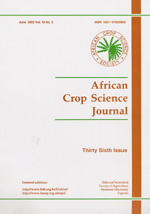
|
African Crop Science Journal
African Crop Science Society
ISSN: 1021-9730
EISSN: 1021-9730
Vol. 9, No. 1, 2001, pp. 83-96
|
 Bioline Code: cs01038
Bioline Code: cs01038
Full paper language: English
Document type: Research Article
Document available free of charge
|
|
|
African Crop Science Journal, Vol. 9, No. 1, 2001, pp. 83-96
| en |
Effect of Intercropping Maize and Solanum Potato on Yield of the Component Crops in Central Uganda
Ebwongu, M.; Adipala, E.; Ssekabembe, C.K.; Kyamanywa, S. & Bhagsari, A.S.
Abstract
Three potato (Solunum tuberosum) varieties and one maize variety were
intercropped in six spatial arrangements, viz., sole crops, 2:1, 2:2, 1:1, 1:2
potato: maize row arrangements and one additive mixture. Intercropping influenced
some growth parameters of potato but not of maize. For instance, the rate of
potato stem extension and leaf formation rates were hastened by intercropping.
Branching in potato influenced leaf area development, especially during the
second season when the additive mixture supported the least leaf area. Potato
yield differed significantly among the spatial arrangements with the highest
yield in the sole crop followed closely by the 2:1 and 2:2 potato: maize mixtures.
However, these yield differences depended on potato variety, with Kisoro being
the most responsive to changes in spatial arrangement. Assessment of biological
efficiency of intercropping using the Land Equivalent Ratio (LER) method, revealed
that yield advantages increased slightly with increase in the proportion of
potato in the mixtures. However, it was only the additive mixture with a significant
overall LER of 1.58, indicating a 58.2% yield advantage for intercropping. The
contribution of maize to total LER was greatest in the 1:2 and additive mixtures.
Keywords
Biological efficiency, inter-cropping, land equivalent ratio, Solanum tuberosum, spatial arrangement, yield advantage
|
| |
| fr |
Ebwongu, M.; Adipala, E.; Ssekabembe, C.K.; Kyamanywa, S. & Bhagsari, A.S.
Résumé
Trois variétés de pomme de terre (Solanum tuberosum) et
une variété de maïs ont été associées
dans six arrangements spatiaux à savoir: la monoculture, 2:1, 2:2, 1:1,
1:2 arrangement en lignes de pomme de terre et de maïs et un mélange
additionel. L'association des cultures a influencé certains paramètres
de croissance de la pomme de terre et ne pas ceux du maïs. Ainsi le taux
d' élongation de la tige de la pomme de terre et le taux de formation
des feuilles ont été favorisés par l'association. Le branchement
de la pomme de terre a favorisé le développement de la surface
foliaire particulièrement durant la deuxième période de
pluies et le mélange additionel a supporté la surface foliaire.
Les rendements de la pomme de terre ont differé significativement entre
les différents arrangements spatiaux et le rendement le plus elevé
a été obtenu dans la monoculture étroitement suivi par
l'arrangement 2:1 et 2:2 de maïs et de pomme de terre. Cependant ces différences
dépendaient de la variété et Kisoro fut la variété
qui a répondu le plus aux changements d' arrangement spatial. L' évaluation
de l' éfficacite de l' association par la méthode de Land Equivalent
Ratio (LER), a montré que les avantages de rendements ont augmenté
partiellement avec l'augmentation de la proportion de pomme de terre dans les
associations. Mais, c' était seulement le mélange additionel qui
a eu un important LER de 1.58 montrant un avantage de rendement de 58.2% pour
l'association culturale. La contribution du maïs sur le LER total était
la plus grande dans l'arrangement 1:2 et le mélange additionel.
Mots Clés
Efficacite biologique, association culturale, land equivalent ratio, Solanum tuberosum, arrangement spatial, avantage de rendement
|
| |
© Copyright 2001 - African Crop Science Society
|
|
